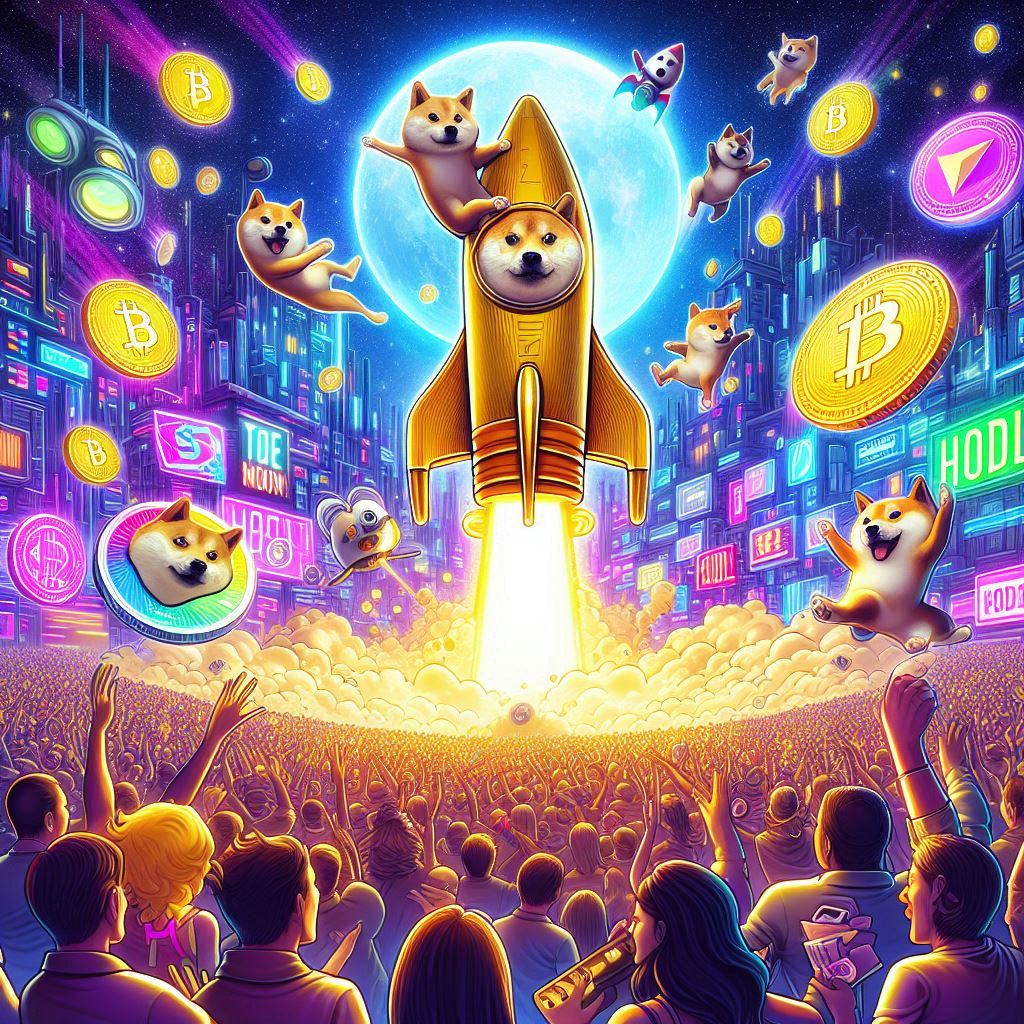
In the beginning, there was Bitcoin. And then, someone said, ‘Let there be Doge.’ And lo, the meme coin was born—because apparently, the crypto world needed more chaos and Shiba Inus
Some Random Reddit Guy
Welcome, dear reader, to the wild, wacky, and occasionally wallet-draining world of meme coins. If you’ve ever wondered how a joke cryptocurrency featuring a dog became a multi-billion-dollar phenomenon, buckle up. This is the story of how meme coins went from “lol, what?” to “OMG, Lambo?”—a tale filled with satire, absurdity, and a dash of existential philosophy.
Meme coins are cryptocurrencies inspired by internet memes or trends. They often lack serious utility, focusing on community and entertainment. Dogecoin, the first meme coin, emerged in 2013 as a playful parody.
The rise of meme coins is attributed to factors like social media hype, celebrity endorsements, and the potential for rapid price appreciation. While they offer the thrill of quick gains, meme coins are highly volatile and carry significant investment risks.
Examples include Shiba Inu, inspired by Dogecoin, and Pepe Coin, based on the Pepe the Frog meme. These coins demonstrate the unique blend of internet culture and cryptocurrency, highlighting both the potential for rapid growth and the inherent risks associated with this speculative market segment.
The Birth of Meme Coins: When the Internet Met Crypto
Let’s set the scene: it’s 2013, and Bitcoin is slowly gaining traction as the digital gold of the future. Meanwhile, in a dark corner of the internet, two software engineers, Billy Markus and Jackson Palmer, decided to create a cryptocurrency as a joke. Enter **Dogecoin (DOGE)**, the OG meme coin, inspired by the iconic Shiba Inu dog meme.
Dogecoin was never meant to be taken seriously. It was a parody of the crypto world’s obsession with getting rich quick. But here’s the kicker: the internet loved it. Dogecoin became a symbol of fun, community, and tipping people online for no reason other than “why not?”
“Dogecoin was like the class clown who accidentally became valedictorian. Nobody saw it coming, least of all its creators.”
The genesis of meme coins lies in the intersection of crypto’s nascent blockchain technology and the burgeoning meme culture of the early internet. Dogecoin, the progenitor, emerged from this fertile ground in 2013, leveraging the Shiba Inu “Doge” meme to create a playful, community-driven cryptocurrency. This unconventional approach, emphasizing humor and virality over traditional financial utility, laid the groundwork for a new breed of crypto assets.
The subsequent rise of meme coins can be attributed to several key factors. Firstly, the inherent virality of memes facilitated rapid community growth and organic marketing, amplifying their reach and influence. Secondly, the decentralized nature of blockchain technology aligned with the anti-establishment ethos often associated with meme culture, fostering a sense of collective ownership and empowerment among participants.
Furthermore, the speculative nature of cryptocurrency markets, with their inherent volatility and potential for rapid gains, proved to be a fertile ground for meme coins to thrive. The inherent unpredictability of meme coin markets, driven by social trends and community sentiment, further fueled their allure, attracting a diverse range of investors, from seasoned traders to newcomers drawn to the excitement and potential for rapid returns.
The Philosophy of Meme Coins: Why Do They Even Exist?
Meme coins are the ultimate expression of internet culture. They’re absurd, unpredictable, and often completely devoid of utility. But isn’t that kind of the point?
In a world where traditional finance feels like a dystopian nightmare, meme coins offer a refreshing dose of chaos. They’re the financial equivalent of a whoopee cushion at a board meeting. And let’s be honest, isn’t life just a little more fun when you can say, “I own 10 million Shiba Inu tokens”?
Meme coins are like existentialism for your wallet. They make you question the meaning of value, purpose, and why you spent $500 on a coin named after a dog.
Meme coins exist in a fascinating gray area between serious finance and playful internet culture. They challenge traditional notions of value, demonstrating that perceived worth can be highly subjective and influenced by social trends, humor, and community sentiment.
The psychological drivers behind meme coin investments are complex. Fear of missing out (FOMO), herd mentality, and the thrill of potentially rapid gains play significant roles. The low entry barrier and the democratization of access to cryptocurrency markets further contribute to their appeal.
However, meme coins also raise questions about the nature of value, the role of speculation in financial markets, and the potential for manipulation and exploitation. Understanding the psychological and philosophical underpinnings of meme coin phenomena can provide valuable insights into the evolving relationship between technology, culture, and finance in the digital age.
The Dogecoin Phenomenon: From Meme to Mainstream
Dogecoin’s rise to fame was anything but ordinary. It started as a joke, but then something strange happened: people started using it. Dogecoin funded charitable causes, sponsored NASCAR drivers, and even sent the Jamaican bobsled team to the Olympics.
But the real turning point came when Elon Musk, the meme lord of Twitter, started tweeting about it. Suddenly, Dogecoin wasn’t just a meme—it was a movement. And like any good meme, it spread faster than a viral cat video.
Elon Musk tweeting about Dogecoin was like Oprah giving away cars, except instead of cars, it was a cryptocurrency with a dog on it
Dogecoin, the “meme coin” that took the crypto world by storm, boasts some truly quirky trivia. Did you know its logo is a Shiba Inu with sunglasses and a fedora? Talk about a fashion statement! This digital currency, born from a playful internet meme, has a surprisingly philanthropic side. The Dogecoin community has famously rallied together to fund various charitable causes, from sending the Jamaican bobsled team to the Olympics to supporting a NASCAR driver.
Beyond the fun, Dogecoin’s journey highlights some interesting facts. Its unlimited supply, a stark contrast to Bitcoin’s scarcity, makes it a unique proposition in the crypto space. And let’s not forget the role of Elon Musk, whose tweets have sent Dogecoin’s price on wild rides, showcasing the influence of social media on cryptocurrency markets.
The Copycats: When Meme Coins Went Wild

Once Dogecoin proved that meme coins could be profitable, the floodgates opened. Suddenly, every animal, vegetable, and mineral had its own cryptocurrency. There was **Shiba Inu (SHIB)**, **Dogelon Mars (ELON)**, and even **CumRocket (CUMMIES)**—because why not?
These coins were often created as jokes, but they quickly gained traction thanks to their vibrant communities and the promise of “moonshots.” Of course, not all of them survived. Many meme coins crashed and burned faster than a TikTok trend.
*“The meme coin market is like a zoo, except the animals are all Shiba Inus, and the zookeepers are high on Red Bull.”*
Following Dogecoin’s success in 2013, a wave of “copycat” meme coins emerged. Shiba Inu (SHIB), launched in 2020, capitalized on Dogecoin’s popularity, leading to a surge in dog-themed coins. 2021 saw a frenzy of new meme coins, including Floki Inu, inspired by Elon Musk’s pet dog. The Pepe Coin, inspired by the Pepe the Frog meme, gained significant traction in 2023. This period witnessed a rapid proliferation of meme coins, each attempting to capitalize on internet trends, celebrity endorsements, and the allure of quick gains, highlighting the speculative nature of this sector.
The Role of Social Media: Meme Coins Go Viral
If meme coins are the stars of the crypto world, then social media is their stage. Platforms like Twitter, Reddit, and TikTok have played a crucial role in the rise of meme coins.
Take **GameStop (GME)** and **AMC (AMC)**, for example. These stocks became meme sensations thanks to Reddit’s WallStreetBets community. Meme coins followed a similar trajectory, with communities rallying behind their favorite tokens and driving up prices through sheer hype.
*“Social media is the ultimate meme coin amplifier. It’s like a megaphone, except instead of sound, it’s just people yelling ‘TO THE MOON!’”*
Social media has played a pivotal role in the rise of meme coins, turning them from niche digital assets into global phenomena. Dogecoin, initially created in 2013 as a joke, became one of the most popular meme coins thanks to viral support on platforms like Reddit, Twitter, and TikTok. The “Doge” meme, featuring a Shiba Inu dog, quickly gained a cult following. In 2021, Dogecoin saw a dramatic increase in value after high-profile endorsements, especially from Elon Musk, whose tweets regularly sparked price surges.
Similarly, Shiba Inu, another meme coin, capitalized on the viral success of Dogecoin and gained millions of investors, partly due to its widespread promotion on social media. In 2021, it reached an all-time high market cap of $41 billion, fueled by online communities on Reddit’s r/cryptocurrency and Twitter.
These examples show how social media influencers and communities can influence meme coin trends, leading to dramatic market shifts and widespread attention.
The Dark Side of Meme Coins: Rug Pulls and Scams
Not all meme coins are created equal. While some, like Dogecoin and Shiba Inu, have stood the test of time, others are outright scams. These “rug pull” coins are created by developers who abandon the project after pocketing investors’ money.
It’s a harsh reminder that the meme coin market is the Wild West of crypto. For every success story, there are countless failures—and a few outright frauds.
*“Investing in meme coins is like playing Russian roulette, except the bullets are made of memes, and the gun is your bank account.”*
While meme coins can generate significant profits, they also carry serious risks, particularly scams and “rug pulls.” A “rug pull” occurs when developers abandon a project after inflating the coin’s value, leaving investors with worthless assets. One notorious example is the Squid Game token, launched in late 2021, which soared in value before its creators disappeared with an estimated $3 million. The token, inspired by the hit Netflix series, attracted thousands of investors who were left with nothing when the price crashed to zero.
Another risk is the prevalence of “pump and dump” schemes, where the value of meme coins is artificially inflated through coordinated social media efforts, only for the creators to sell off their holdings at the peak. Investors are left with substantial losses once the price crashes.
For potential investors, it’s crucial to approach meme coins with caution, thoroughly researching any project and recognizing the signs of scams to avoid financial loss.
The Psychology of Meme Coin Investors: Why Do We Do This to Ourselves?
Let’s face it: investing in meme coins is not for the faint of heart. It’s a rollercoaster of emotions, from the euphoria of a price spike to the despair of a crash.
But why do we do it? Part of it is the thrill of the gamble. Part of it is the fear of missing out (FOMO). And part of it is the hope that maybe, just maybe, we’ll strike it rich and retire to a private island.
Meme coin investors are like moths to a flame, except the flame is a Shiba Inu, and the moth is your life savings.
The Future of Meme Coins: Are They Here to Stay?
Love them or hate them, meme coins are here to stay—at least for now. They’ve become a permanent fixture in the crypto world, offering a unique blend of humor, community, and financial speculation.
But as the market matures, we may see fewer meme coins and more projects with actual utility. After all, even the internet has its limits.
The future of meme coins is like the future of humanity: uncertain, chaotic, and probably involving more dogs.

Lessons from Meme Coins: What Can We Learn?
Meme coins may seem like a joke, but they’ve taught us some valuable lessons. They’ve shown the power of community, the importance of humor, and the dangers of hype.
They’ve also reminded us that in the world of crypto, anything is possible. Whether that’s a good thing or a bad thing is up to you.
“Meme coins are like life: unpredictable, absurd, and occasionally profitable.”
Meme coins like Dogecoin (DOGE) and Shiba Inu (SHIB) have taught us valuable lessons about cryptocurrency trends. Born from internet jokes, these coins gained massive popularity due to community-driven hype and celebrity endorsements (e.g., Elon Musk tweeting about Dogecoin). They highlight the power of social media influence and speculative investing, but also the risks of volatility. For instance, Dogecoin surged over 12,000% in 2021 but later dropped significantly.
Key takeaways:
- Community matters: Strong, engaged communities can drive value.
- Volatility is real: High rewards come with high risks.
- Innovation isn’t everything: Even “joke” projects can succeed with the right marketing.
Conclusion: The Meme Coin Legacy
So, what’s the legacy of meme coins? They’ve brought laughter, chaos, and a few Lamborghinis to the crypto world. They’ve proven that even the silliest ideas can have value—if enough people believe in them.
And perhaps most importantly, they’ve reminded us not to take life (or crypto) too seriously. After all, if a coin named after a dog can make millionaires, maybe anything is possible.
In the end, meme coins are more than just a financial phenomenon. They’re a testament to the power of memes, the internet, and the human spirit. And also, dogs.

